clutch DATSUN B110 1973 Service Repair Manual
[x] Cancel search | Manufacturer: DATSUN, Model Year: 1973, Model line: B110, Model: DATSUN B110 1973Pages: 513, PDF Size: 28.74 MB
Page 4 of 513
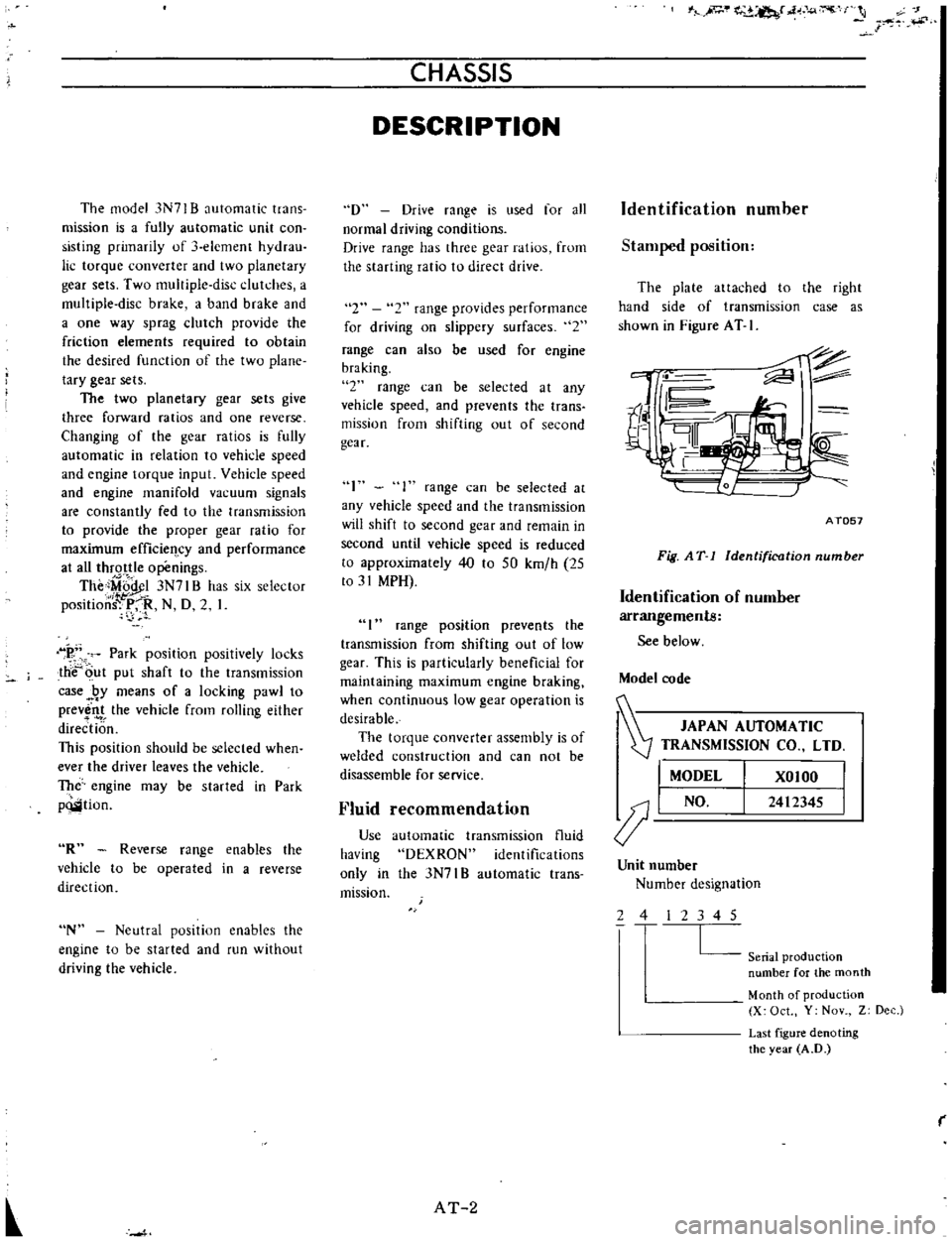
The
model
3N71
B
automatic
trans
mission
is
a
fully
automatic
unit
con
sisting
primarily
of
element
hydrau
lic
torque
converter
and
two
planetary
gear
sets
Two
multiple
disc
clutches
a
muItiple
disc
brake
a
band
brake
and
a
one
way
sprag
clutch
provide
the
friction
elements
required
to
obtain
the
desired
function
of
the
two
plane
tary
gear
sets
The
two
planetary
gear
sets
give
three
forward
ratios
and
one
reverse
Changing
of
the
gear
ratios
is
fully
automatic
in
relation
to
vehicle
speed
and
engine
torque
input
Vehicle
speed
and
engine
manifold
vacuum
signals
are
constantly
fed
to
the
transmission
to
provide
the
proper
gear
ratio
for
maximum
efficieq
cy
and
performance
at
all
thrqttIe
openings
The
iMiij
l
3N7I
B
has
six
selector
position
f
P
R
N
D
2
1
k
Park
position
positively
locks
the
c
ut
put
shaft
to
the
transmission
case
RY
means
of
a
locking
pawl
to
prev
nt
the
vehicle
from
rolling
either
direction
This
position
should
be
selected
when
ever
the
driver
leaves
the
vehicle
The
engine
may
be
started
in
Park
pQlition
OR
Reverse
range
enables
the
vehicle
to
be
operated
in
a
reverse
direction
N
Neutral
posItion
enables
the
engine
to
be
started
and
run
without
driving
the
vehicle
CHASSIS
DESCRIPTION
D
Drive
range
is
used
for
all
normal
driving
conditions
Drive
range
has
three
gear
ratios
frum
the
starting
ratio
to
direct
drive
2
2
range
provides
performance
for
driving
on
slippery
surfaces
2
range
can
also
be
used
for
engine
braking
2
range
can
be
selected
at
any
vehicle
speed
and
prevents
the
trans
mission
from
shifting
out
of
second
gear
I
range
can
be
selected
at
any
vehicle
speed
and
the
transmission
will
shift
to
second
gear
and
remain
in
second
until
vehide
speed
is
reduced
to
approximately
40
to
50
kmfh
25
to
31
MPH
I
range
position
prevents
the
transmission
from
shifting
out
of
low
gear
This
is
particularly
beneficial
for
maintaining
maximum
engine
braking
when
continuous
low
gear
operation
is
desirable
The
torque
converter
assembly
is
of
welded
construction
and
can
not
be
disassemble
for
service
Fluid
recommendation
Use
having
only
in
mission
automatic
transmission
fluid
DEXRON
identifications
the
3N7I
B
automatic
trans
AT
2
IA
e
l
csr
4o
J
r
s
Identification
number
Stamped
position
The
plate
attached
to
the
right
hand
side
of
transmission
case
as
shown
in
Figure
AT
I
ii
II
r
4
1
r
I
to
i
AT057
Fig
AT
1
Identification
number
Identification
of
number
arrangements
See
below
Model
code
JAPAN
AUTOMATIC
Z
TRANSMISSION
CO
LTD
I
MODEL
XOIOO
J
I
NO
2412345
Unit
number
Number
designation
2
4
2
3
4
5
L
Seriat
production
number
for
the
month
Month
of
production
X
Oct
Y
Nov
Z
Dec
Last
figure
denoting
the
year
A
D
r
Page 5 of 513
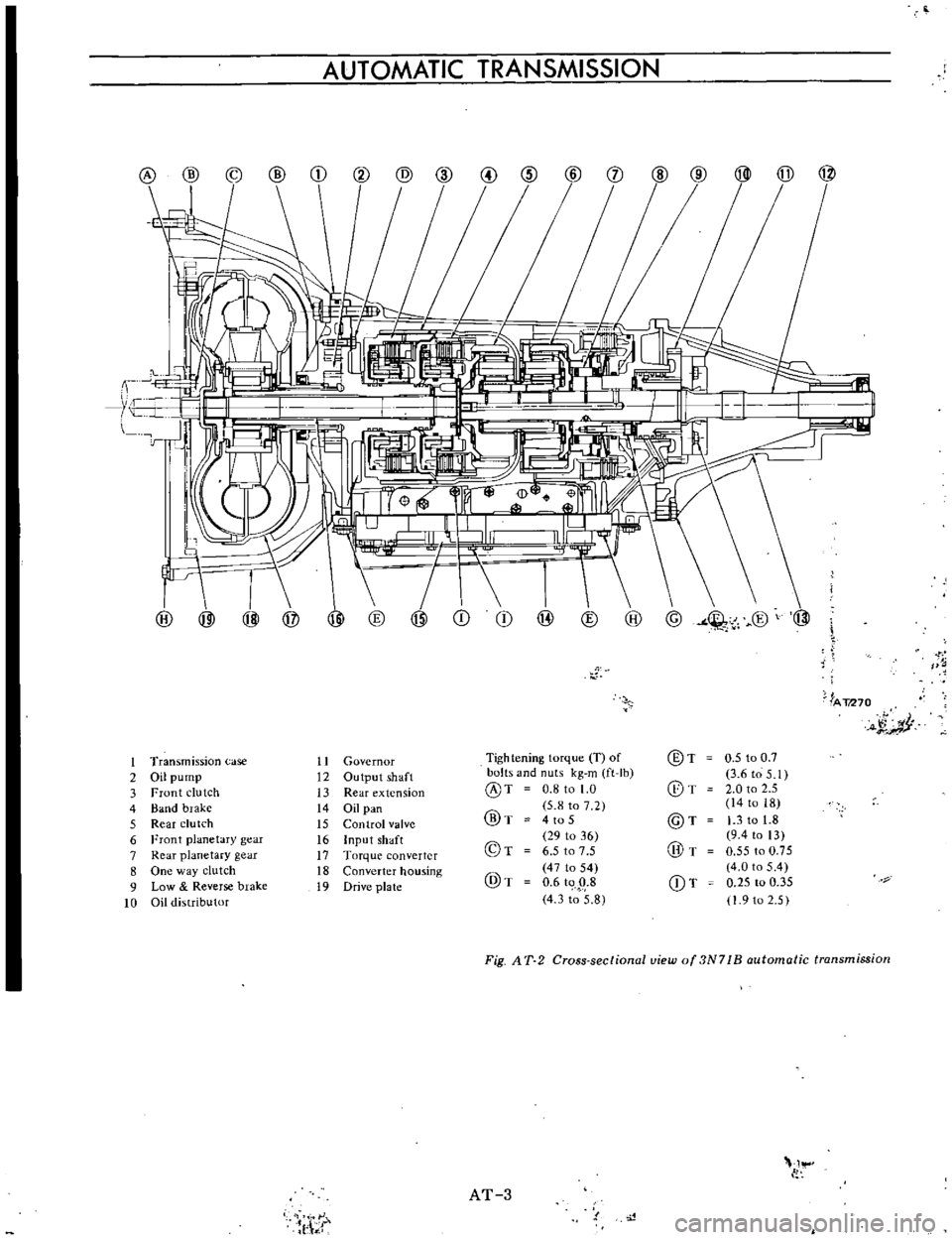
AUTOMATIC
TRANSMISSION
1
1
1
I
L
@
CD
@
@
ID
@
@
h
r
H
@
@
@
@
@
@
@
4
@
@
t
I
fA
TIl70
4
t
ill
pJrP
I
Transmission
ase
II
Governor
Tightening
torque
T
of
@T
0
5
to
0
7
2
Oil
pump
12
Output
shaft
bolts
and
nuts
kg
rn
ft
Ib
3
6
to
5
1
3
Front
clutch
13
Rear
xtcnsion
@T
0
8
to
1
0
@T
2
0
to
2
5
4
Band
brake
14
Oil
pan
@T
5
8
to
7
2
14
to
18
5
Rear
clutch
15
Control
valve
4
to
5
@T
1
3
to
1
8
6
Front
planetary
gt
ar
16
Input
shaft
@T
29
to
36
9
4
to
13
7
Rear
planetary
gear
17
Torque
converter
6
5
to
7
5
@T
0
55
to
0
75
8
One
way
clutch
18
Converter
housing
@T
47
to
54
4
0
to
5
4
9
Low
Reverse
brake
19
Drive
plate
0
6
h
Q
8
Q
T
0
25
to
0
35
10
Oil
distributor
4
3
to
5
8
1
9
to
2
5
Fig
AT
2
Cross
sectional
uiew
of
3N71
B
automatic
transmission
I
AT
3
l
t
Page 6 of 513
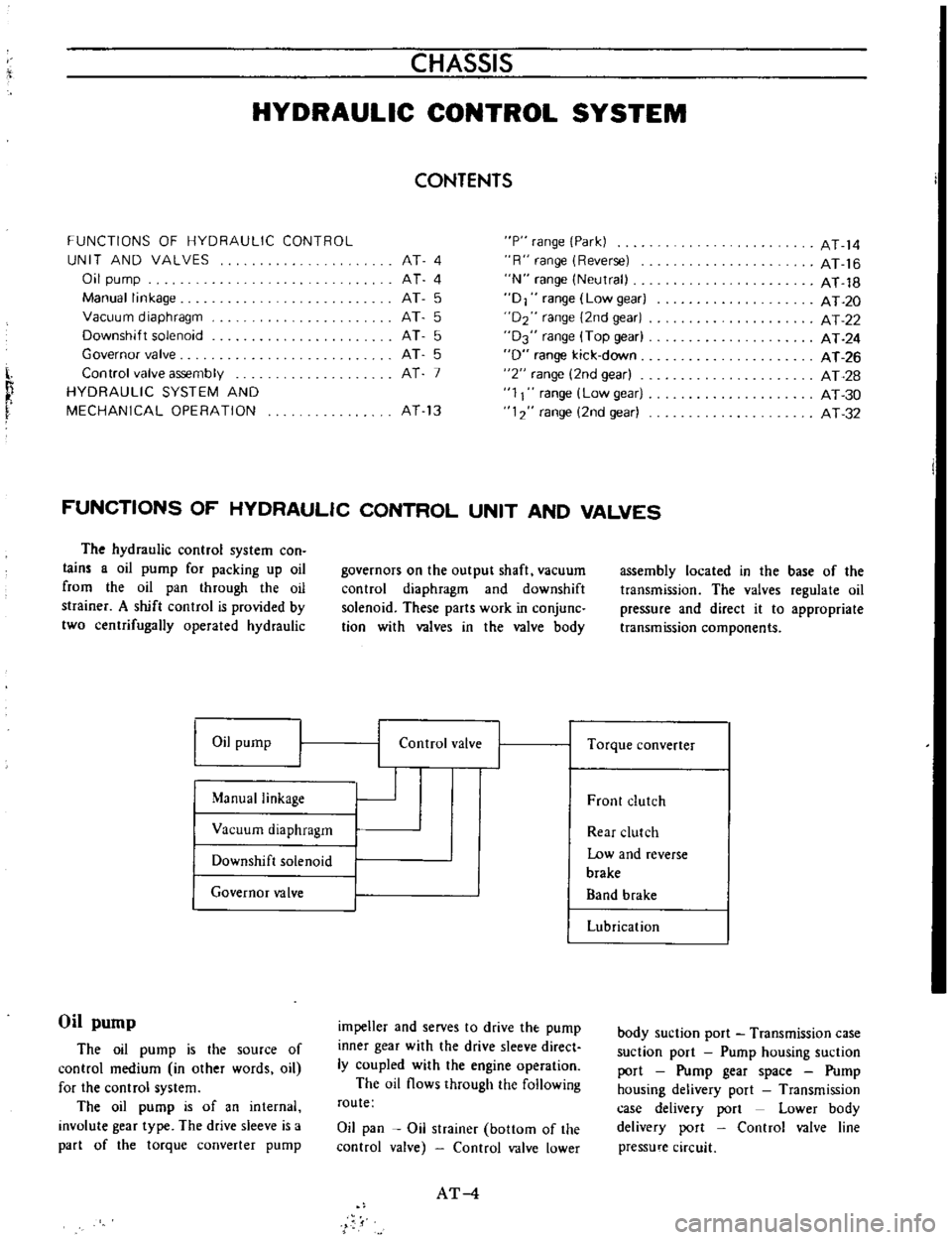
CHASSIS
HYDRAULIC
CONTROL
SYSTEM
l
FUNCTIONS
OF
HYDRAULIC
CONTROL
UNIT
AND
VALVES
Oil
pump
Manual
linkage
Vacuum
diaphragm
Downshift
solenoid
Governor
valve
Control
valve
assembly
HYDRAULIC
SYSTEM
AND
MECHANICAL
OPERATION
CONTENTS
P
range
Park
R
range
Reverse
N
range
Neutral
D
range
Low
gear
D2
range
2nd
gear
D3
range
Top
gear
D
range
kick
down
2
range
2nd
gear
1
range
Low
gear
12
range
2nd
gear
AT
4
AT
4
AT
5
AT
5
AT
5
AT
5
AT
7
AT13
AT
14
AT
16
AT
18
AT
20
AT
22
AT
24
AT
26
AT
28
AT
30
AT
32
FUNCTIONS
OF
HYDRAULIC
CONTROL
UNIT
AND
VALVES
The
hydraulic
control
system
con
lain
a
oil
pump
for
packing
up
oil
from
the
oil
pan
through
the
oil
strainer
A
shift
control
is
provided
by
two
centrifugally
operated
hydraulic
Oil
pump
Manual
linkage
Vacuum
diaphragm
Downshift
solenoid
Governor
valve
Oil
pump
The
oil
pump
is
the
source
of
control
medium
in
other
words
oil
for
the
control
system
The
oil
pump
is
of
an
internal
involute
gear
type
The
drive
sleeve
is
a
part
of
the
torque
converter
pump
governors
on
the
output
shaft
vacuum
control
diaphragm
and
downshift
solenoid
These
parts
work
in
conjunc
tion
with
valves
in
the
valve
body
I
I
Control
valve
impeller
and
serves
to
drive
the
pump
inner
gear
with
the
drive
sleeve
direct
ly
coupled
with
the
engine
operation
The
oil
flows
through
the
following
route
Oil
pan
Oil
strainer
bottom
of
the
control
valve
Control
valve
lower
AT
4
assembly
located
in
the
base
of
the
transmission
The
valves
regulate
oil
pressure
and
direct
it
to
appropriate
transmission
components
I
Torque
converter
Front
clutch
Rear
clutch
Low
and
reverse
brake
Band
brake
Lubrication
body
suction
port
Transmission
case
suction
port
Pump
housing
suction
port
Pump
gear
space
Pump
housing
delivery
port
Transmission
case
delivery
port
Lower
body
delivery
port
Control
valve
line
pressure
circuit
Page 11 of 513
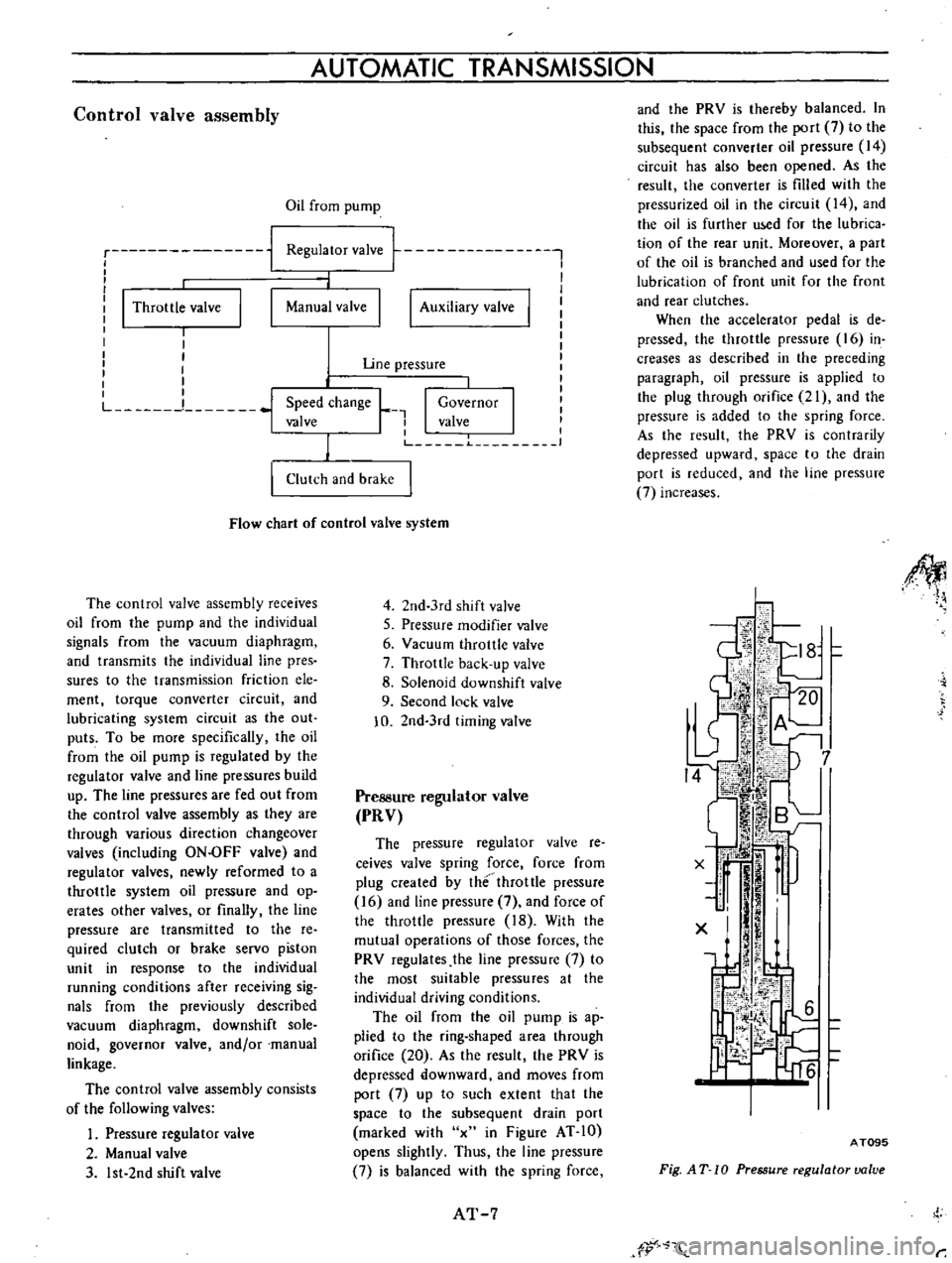
Control
valve
assembly
AUTOMATIC
TRANSMISSION
Oil
from
pump
ru
nn
i
I
I
I
Throttle
valve
I
I
1
m
nn
I
Auxiliary
valve
I
Regulator
valve
j
Manual
valve
I
Uoe
pressure
Speed
change
L
I
Governor
valve
I
I
valve
J
1
1
Clutch
and
brake
Flow
chart
of
control
valve
system
The
control
valve
assembly
receives
oil
from
the
pump
and
the
individual
signals
from
the
vacuum
diaphragm
and
transmits
the
individual
line
pres
sures
to
the
transmission
friction
ele
ment
torque
converter
circuit
and
lubricating
system
circuit
as
the
out
puts
To
be
more
specifically
the
oil
from
the
oil
pump
is
regulated
by
the
regulator
valve
and
line
pressures
build
up
The
line
pressures
are
fed
out
from
the
control
valve
assembly
as
they
are
through
various
direction
changeover
valves
including
ON
OFF
valve
and
regulator
valves
newly
reformed
to
a
throttle
system
oil
pressure
and
op
crates
other
valves
or
finally
the
line
pressure
are
transmitted
to
the
re
quired
clutch
or
brake
servo
piston
unit
in
response
to
the
individual
running
conditions
after
receiving
sig
nals
from
the
previously
described
vacuum
diaphragm
downshift
sole
noid
governor
valve
and
or
manual
linkage
The
control
valve
assembly
consists
of
the
following
valves
Pressure
regulator
valve
2
Manual
valve
3
1st
2nd
shift
valve
4
2nd
3rd
shift
valve
S
Pressure
modifier
valve
6
Yacuum
throttle
valve
7
Throttle
back
up
valve
8
Solenoid
downshift
valve
9
Second
lock
valve
0
2nd
3rd
timing
valve
Pressure
regulator
valve
PRV
The
pressure
regulator
valve
re
ceives
valve
spring
force
force
from
plug
created
by
the
throttle
pressure
16
and
line
pressure
7
and
force
of
the
throttle
pressure
18
With
the
mutual
operations
of
those
forces
the
PRY
regulates
the
line
pressure
7
to
the
most
suitable
pressures
at
the
individual
driving
conditions
The
oil
from
the
oil
pump
is
ap
plied
to
the
ring
shaped
area
through
orifice
20
As
the
result
the
PRY
is
depressed
downward
and
moves
from
port
7
up
to
such
extent
that
the
space
to
the
subsequent
drain
port
marked
with
x
in
Figure
AT
10
opens
slightly
Thus
the
line
pressure
7
is
balanced
with
the
spring
force
AT
7
and
the
PRY
is
thereby
balanced
In
this
the
space
from
the
port
7
to
the
subsequent
converter
oil
pressure
14
circuit
has
also
been
opened
As
the
result
the
converter
is
filled
with
the
pressurized
oil
in
the
circuit
14
and
the
oil
is
further
u
d
for
the
Iubrica
tion
of
the
rear
unit
Moreover
a
part
of
the
oil
is
branched
and
used
for
the
lubrication
of
front
unit
for
the
front
and
rear
clutches
When
the
accelerator
pedal
is
de
pressed
the
throttle
pressure
16
in
creases
as
described
in
the
preceding
paragraph
oil
pressure
is
applied
to
the
plug
through
orifice
21
and
the
pressure
is
added
to
the
spring
force
As
the
result
the
PRY
is
contrarily
depressed
upward
space
to
the
drain
port
is
reduced
and
the
line
pressure
7
increases
Afl
II
Jwi
06
A
J
L
I
7
I
tf
Iij
BL
i
il
J
jti
r
x
r
1
J
I
l
I
X
6
C
l
o
ii
J
f
A
T09S
Fig
AT
10
Pressure
regulator
value
tr
r
Page 12 of 513
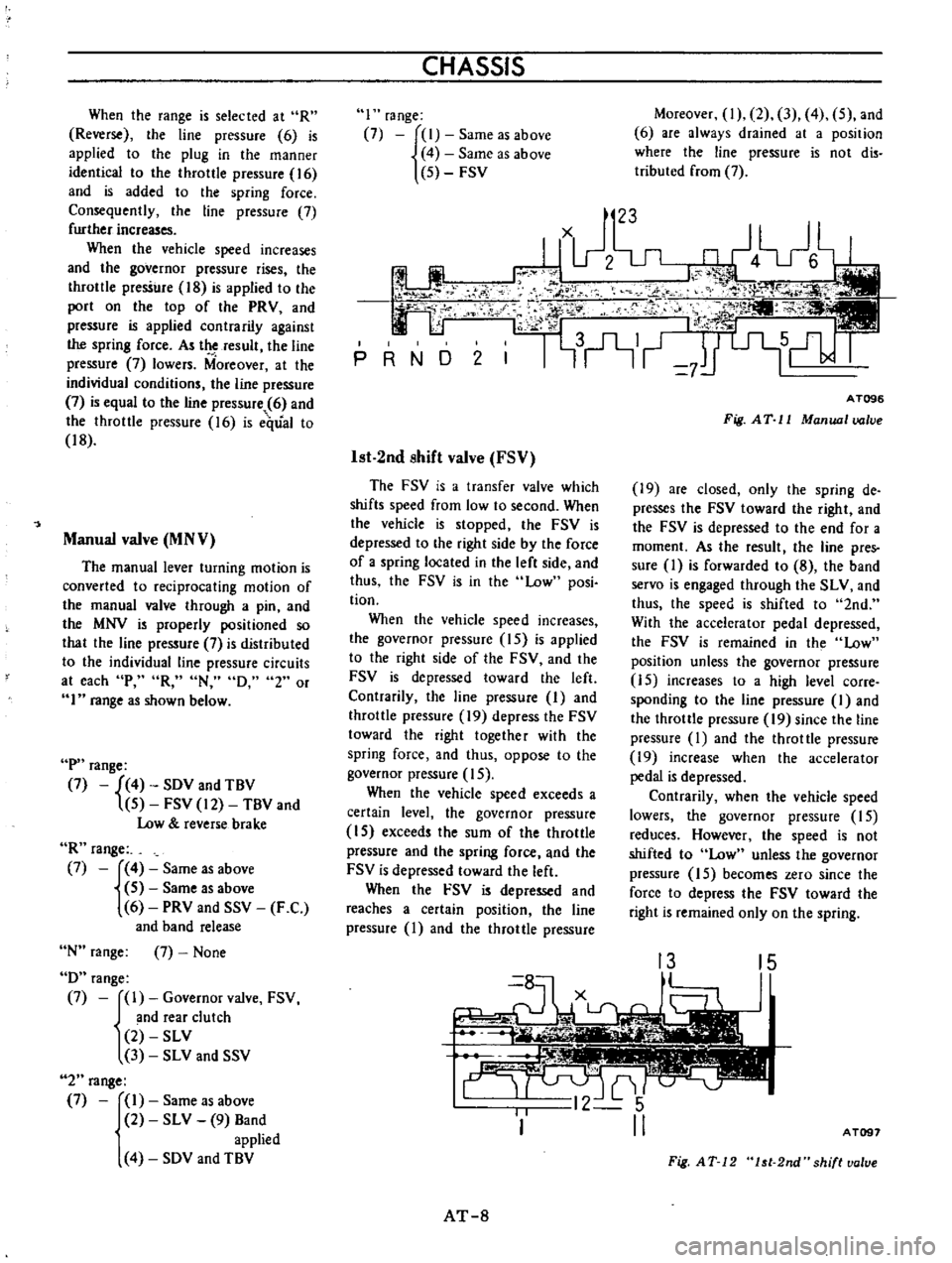
When
the
range
is
selected
at
R
Reverse
the
line
pressure
6
is
applied
to
the
plug
in
the
manner
identical
to
the
throttle
pressure
16
and
is
added
to
the
spring
force
Consequently
the
line
pressure
7
further
increases
When
the
vehicle
speed
increases
and
the
governor
pressure
rises
the
throttle
presSure
18
is
applied
to
the
port
on
the
top
of
the
PRY
and
pressure
is
applied
contrarily
against
the
spring
force
As
the
result
the
line
pressure
7
lowers
Moreover
at
the
individual
conditions
the
line
pressure
7
is
equal
to
the
line
pressure
6
and
the
throttle
pressure
16
is
e
qual
to
18
Manual
valve
MNV
The
manual
lever
turning
motion
is
converted
to
reciprocating
motion
of
the
manual
valve
through
a
pin
and
the
MNV
is
properly
positioned
so
that
the
line
pressure
7
is
distributed
to
the
individual
line
pressure
circuits
at
each
P
R
N
D
2
or
I
range
as
shown
below
P
range
7
4
SDV
and
TBV
5
FSV
12
TBV
and
Low
reverse
brake
R
range
7
4
Same
as
above
5
Same
as
above
6
PRY
and
SSV
F
C
and
band
release
N
range
7
None
D
range
7
1
Governor
valve
FSV
and
rear
clutch
2
SLY
3
SLY
and
SSV
2
range
7
1
Same
as
above
2
SL
V
9
Band
applied
4
SDV
and
TBV
CHASSIS
I
range
7
reI
Same
as
above
4
Same
as
above
5
FSV
Moreover
I
2
3
4
5
and
6
are
always
drained
at
a
position
where
the
line
pressure
is
not
dis
tributed
from
7
xJ2
U
I
V
Jl
ft
g
f
P
R
NeD
2
1
3nl
lst
2nd
shift
valve
FSV
The
FSV
is
a
transfer
valve
which
shifts
speed
from
low
to
second
When
the
vehicle
is
stopped
the
FSV
is
depressed
to
the
right
side
by
the
force
of
a
spring
located
in
the
left
side
and
thus
the
FSV
is
in
the
Low
posi
tion
When
the
vehicle
speed
increases
the
governor
pressure
IS
is
applied
to
the
right
side
of
the
FSV
and
the
FSV
is
depressed
toward
the
left
Contrarily
the
line
pressure
I
and
throttle
pressure
19
depress
the
FSV
toward
the
right
together
with
the
spring
force
and
thus
oppose
to
the
governor
pressure
IS
When
the
vehicle
speed
exceeds
a
certain
level
the
governor
pressure
15
exceeds
the
sum
of
the
throttle
pressure
and
the
spring
force
and
the
FSV
is
depressed
toward
the
left
When
the
I
SV
is
depressed
and
reaches
a
certain
position
the
line
pressure
1
and
the
throttle
pressure
fl
4V6
I
I
l
t
I
1
f
7V
5
AT096
Fig
A
T
II
Manual
ualve
19
are
closed
only
the
spring
de
presses
the
FSV
toward
the
right
and
the
FSV
is
depressed
to
the
end
for
a
moment
As
the
result
the
line
pres
sure
I
is
forwarded
to
8
the
band
servo
is
engaged
through
the
SL
V
and
thus
the
speed
is
shifted
to
2nd
With
the
accelerator
pedal
depressed
the
FSV
is
remained
in
the
Low
position
unless
the
governor
pressure
IS
increases
to
a
high
level
cone
sponding
to
the
line
pressure
I
and
the
throttle
pressure
19
since
the
line
pressure
I
and
the
throt
tIe
pressure
19
increase
when
the
accelerator
pedal
is
depressed
Contrarily
when
the
vehicle
speed
lowers
the
governor
pressure
IS
reduces
However
the
speed
is
not
shifted
to
Low
unless
the
governor
pressure
15
becomes
zero
since
the
force
to
depress
the
FSV
toward
the
right
is
remained
only
on
the
spring
15
8
I
72
t
I
05
I
II
AT097
AT
8
Fig
AT
12
1st
2nd
shift
valve
Page 13 of 513
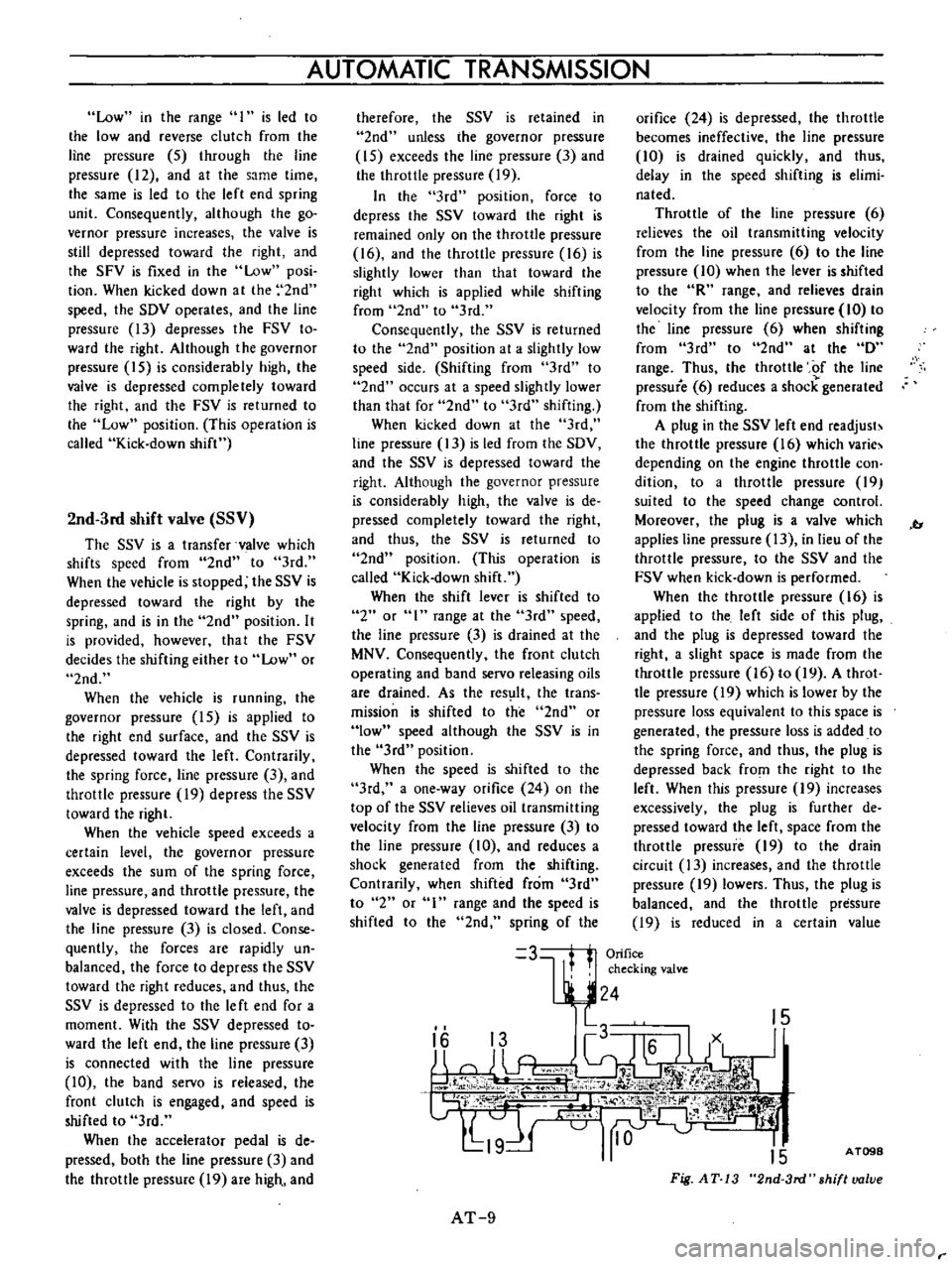
Low
in
the
range
I
is
led
to
the
low
and
reverse
clutch
from
the
line
pressure
5
through
the
line
pressure
12
and
at
the
same
time
the
same
is
led
to
the
left
end
spring
unit
Consequently
although
the
go
vernor
pressure
increases
the
valve
is
still
depressed
toward
the
right
and
the
SFV
is
fixed
in
the
Low
posi
tion
When
kicked
down
at
the
2nd
speed
the
SDV
operates
and
the
line
pressure
13
depresse
the
FSV
to
ward
the
right
Although
the
governor
pressure
15
is
considerably
high
the
valve
is
depressed
completely
toward
the
right
and
the
FSV
is
returned
to
the
Low
position
This
operation
is
called
Kick
down
shift
2nd
3rd
shift
valve
SSV
The
SSV
is
a
transfer
vaIve
which
shifts
speed
from
2nd
to
3rd
When
the
vehicle
is
stopped
the
SSV
is
depressed
toward
the
right
by
the
spring
and
is
in
the
2nd
position
It
is
provided
however
that
the
FSV
decides
the
shifting
either
to
Low
or
2nd
When
the
vehicle
is
running
the
governor
pressure
15
is
applied
to
the
right
end
surface
and
the
SSV
is
depressed
toward
the
left
Contrarily
the
spring
force
line
pressure
3
and
throttle
pressure
19
depress
the
SSV
toward
the
right
When
the
vehicle
speed
exceeds
a
certain
level
the
governor
pressure
exceeds
the
sum
of
the
spring
force
line
pressure
and
throttle
pressure
the
valve
is
depressed
toward
the
left
and
the
line
pressure
3
is
closed
Conse
quently
the
forces
are
rapidly
un
balanced
the
force
to
depress
the
SSV
toward
the
right
reduces
and
thus
the
SSV
is
depressed
to
the
Ie
ft
end
for
a
moment
With
the
SSV
depressed
to
ward
the
left
end
the
line
pressure
3
is
connected
with
the
line
pressure
10
the
band
servo
is
released
the
front
clutch
is
engaged
and
speed
is
shifted
to
3rd
When
the
accelerator
pedal
is
de
pressed
both
the
line
pressure
3
and
the
throttle
pressure
19
are
high
and
AUTOMATIC
TRANSMISSION
therefore
the
SSV
is
retained
in
2nd
unless
ihe
governor
pressure
IS
exceeds
the
line
pressure
3
and
the
throttle
pressure
19
In
the
3rd
position
force
to
depress
the
SSV
toward
the
right
is
remained
only
on
the
throttle
pressure
16
and
the
throttle
pressure
16
is
slightly
lower
than
that
toward
the
right
which
is
applied
while
shifting
from
2nd
to
3rd
Consequently
the
SSV
is
returned
to
the
2nd
position
at
a
slightly
low
speed
side
Shifting
from
3rd
to
2nd
occurs
at
a
speed
slightly
lower
than
that
for
2nd
to
3rd
shifting
When
kicked
down
at
the
3rd
line
pressure
13
is
led
from
the
SDV
and
the
SSV
is
depressed
toward
the
right
Although
the
governor
pressure
is
considerably
high
the
valve
is
de
pressed
completely
toward
the
right
and
thus
the
SSV
is
returned
to
2nd
position
This
operation
is
called
Kick
down
shift
When
the
shift
lever
is
shifted
to
2
or
I
range
at
the
3rd
speed
the
line
pressure
3
is
drained
at
the
MNV
Consequently
the
front
clutch
operating
and
band
servo
releasing
oils
are
drained
As
the
res
lIt
the
trans
mission
is
shifted
to
the
2nd
or
low
speed
although
the
SSV
is
in
the
3rd
position
When
the
speed
is
shifted
to
the
3rd
a
one
way
orifice
24
on
the
top
of
the
SSV
relieves
oil
transmitting
velocity
from
the
line
pressure
3
to
the
line
pressure
10
and
reduces
a
shock
generated
from
the
shifting
Contrarily
when
shifted
from
3rd
to
2
or
range
and
the
speed
is
shifted
to
the
2nd
spring
of
the
orifice
24
is
depressed
the
throttle
becomes
ineffective
the
line
pressure
10
is
drained
quickly
and
thus
delay
in
the
speed
shifting
is
elimi
nated
Throttle
of
the
line
pressure
6
relieves
the
oil
transmitting
velocity
from
the
line
pressure
6
to
the
line
pressure
10
when
the
lever
is
shifted
to
the
R
range
and
relieves
drain
velocity
from
the
line
pressure
10
to
the
line
pressure
6
when
shifting
from
3rd
to
2nd
at
the
D
range
Thus
the
throttle
of
the
line
pressure
6
reduces
a
shock
generated
from
the
shifting
A
plug
in
the
SSV
left
end
readjust
the
throttle
pressure
16
which
varie
depending
on
the
engine
throttle
con
dition
to
a
throttle
pressure
19
suited
to
the
speed
change
control
Moreover
the
plug
is
a
valve
which
applies
line
pressure
13
in
lieu
of
the
throttle
pressure
to
the
SSV
and
the
FSV
when
kick
down
is
performed
When
the
throttle
pressure
16
is
applied
to
the
left
side
of
this
plug
and
the
plug
is
depressed
toward
the
right
a
slight
space
is
made
from
the
throttle
pressure
16
to
19
A
throt
tIe
pressure
19
which
is
lower
by
the
pressure
loss
equivalent
to
this
space
is
generated
the
pressure
loss
is
added
to
the
spring
force
and
thus
the
plug
is
depressed
back
from
the
right
to
the
left
When
this
pressure
19
increases
excessively
the
plug
is
further
de
pressed
toward
the
left
space
from
the
throttle
pressure
19
to
the
drain
circuit
13
increases
and
the
throttle
pressure
19
lowers
Thus
the
plug
is
balanced
and
the
throttle
pressure
19
is
reduced
in
a
certain
value
b
3
Orifice
t
checking
valve
24
15
2
2
i
I
1
c
V
Y
ii
pr
W
jt1
iff
I
W
q
I
nHH
J
L19
H
10
15
AT
9
A
T098
Fig
AT
13
2nd
3rd
shiflvalue
Page 14 of 513
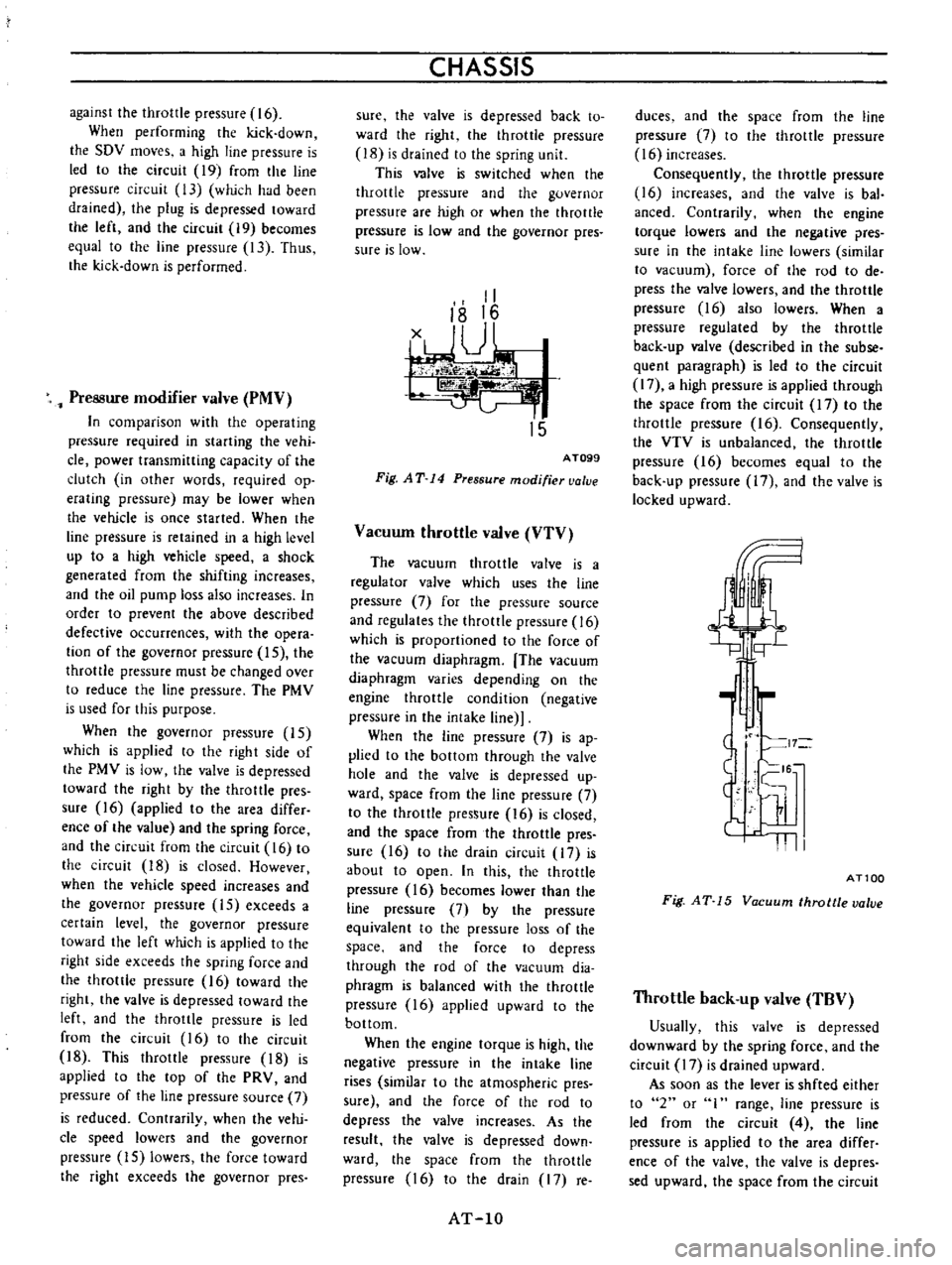
against
the
throttle
pressure
16
When
performing
the
kick
down
the
SOV
moves
a
high
line
pressure
is
led
to
the
circuit
19
from
the
line
pressute
circuit
13
which
had
been
drained
the
plug
is
depressed
toward
the
left
and
the
circuit
19
becomes
equal
to
the
line
pressure
13
Thus
the
kick
down
is
performed
Preasure
modifier
valve
PMV
In
comparison
with
the
operating
pressure
required
in
starting
the
vehi
ele
power
transmitting
capacity
of
the
clutch
in
other
words
required
op
erating
pressure
may
be
lower
when
the
vehicle
is
once
started
When
the
line
pressure
is
retained
in
a
high
level
up
to
a
high
vehicle
speed
a
shock
generated
from
the
shifting
increases
and
the
oil
pump
loss
also
increases
In
order
to
prevent
the
above
described
defective
occurrences
with
the
opera
lion
of
the
governor
pressure
15
the
throttle
pressure
must
be
changed
over
to
reduce
the
line
pressure
The
PMV
is
used
for
this
purpose
When
the
governor
pressure
15
which
is
applied
to
the
right
side
of
the
PMV
is
low
the
valve
is
depressed
toward
the
right
by
the
throttle
pres
sure
16
applied
to
the
area
differ
ence
of
the
value
and
the
spring
force
and
the
circuit
from
the
circuit
16
to
the
circuit
18
is
closed
However
when
the
vehicle
speed
increases
and
the
governor
pressure
15
exceeds
a
certain
level
the
governor
pressure
toward
the
left
which
is
applied
to
the
right
side
exceeds
the
spring
force
and
the
throttle
pressure
16
toward
the
right
the
valve
is
depressed
toward
the
left
and
the
throttle
pressure
is
led
from
the
circuit
16
to
the
circuit
18
This
throttle
pressure
18
is
applied
to
the
top
of
the
PRY
and
pressure
of
the
line
pressure
source
7
is
reduced
Contrarily
when
the
vehi
cle
speed
lowers
and
the
governor
pressure
15
lowers
the
force
toward
the
right
exceeds
the
governor
pres
CHASSIS
sure
the
valve
is
depressed
back
to
ward
the
right
the
throttle
pressure
18
is
drained
to
the
spring
unit
This
valve
is
switched
when
the
throttle
pressure
and
the
governor
pressure
are
high
or
when
the
throttle
pressure
is
low
and
the
governor
pres
sure
is
low
II
18
16
1JU
k
I
15
AT099
Fig
AT
14
Pressure
modifier
valve
Vacuum
throttle
valve
VTV
The
vacuum
throttle
valve
is
a
regulator
valve
which
uses
the
line
pressure
7
for
the
pressure
source
and
regulates
the
throttle
pressure
16
which
is
proportioned
to
the
force
of
the
vacuum
diaphragm
The
vacuum
diaphragm
varies
depending
on
the
engine
throttle
condition
negative
pressure
in
the
intake
line
When
the
line
pressure
7
is
ap
plied
to
the
bottom
through
the
valve
hole
and
the
valve
is
depressed
up
ward
space
from
the
line
pressure
7
to
the
throttle
pressure
16
is
closed
and
the
space
from
the
throttle
pres
sure
16
to
the
drain
circuit
17
is
about
to
open
In
this
the
throttle
pressure
16
becomes
lower
than
the
line
pressure
7
by
the
pressure
equivalent
to
the
pressure
loss
of
the
space
and
the
force
to
depress
through
the
rod
of
the
vacuum
dia
phragm
is
balanced
with
the
throttle
pressure
16
applied
upward
to
the
bottom
When
the
engine
torque
is
high
the
negative
pressure
in
the
intake
line
rises
similar
to
the
atmospheric
pres
sure
and
the
force
of
the
rod
to
depress
the
valve
increases
As
the
result
the
valve
is
depressed
down
ward
the
space
from
the
throttle
pressure
16
to
the
drain
17
re
AT
lO
duces
and
the
space
from
the
line
pressure
7
to
the
throttle
pressure
16
increases
Consequently
the
throttle
pressure
16
increases
and
the
valve
is
baI
anced
Contrarily
when
the
engine
torque
lowers
and
the
negative
pres
sure
in
the
intake
line
lowers
similar
to
vacuum
force
of
the
rod
to
de
press
the
valve
lowers
and
the
throttle
pressure
16
also
lowers
When
a
pressure
regulated
by
the
throttle
back
up
valve
described
in
the
subse
quent
paragraph
is
led
to
the
circuit
17
a
high
pressure
is
applied
through
the
space
from
the
circuit
17
to
the
throttle
pressure
16
Consequently
the
VTV
is
unbalanced
the
throttle
pressure
16
becomes
equal
to
the
back
up
ptessure
17
and
the
valve
is
locked
upward
bi
II
I
ATlOa
Fig
AT
15
Vacuum
throttle
valve
Throttle
back
up
valve
TBV
Usually
this
valve
is
depressed
downward
by
the
spring
force
and
the
circuit
17
is
drained
upward
As
soon
as
the
lever
is
shfted
either
to
2
or
range
line
pressure
is
led
from
the
circuit
4
the
line
pressure
is
applied
to
the
area
differ
ence
of
the
valve
the
valve
is
depres
sed
upward
the
space
from
the
circuit
Page 15 of 513
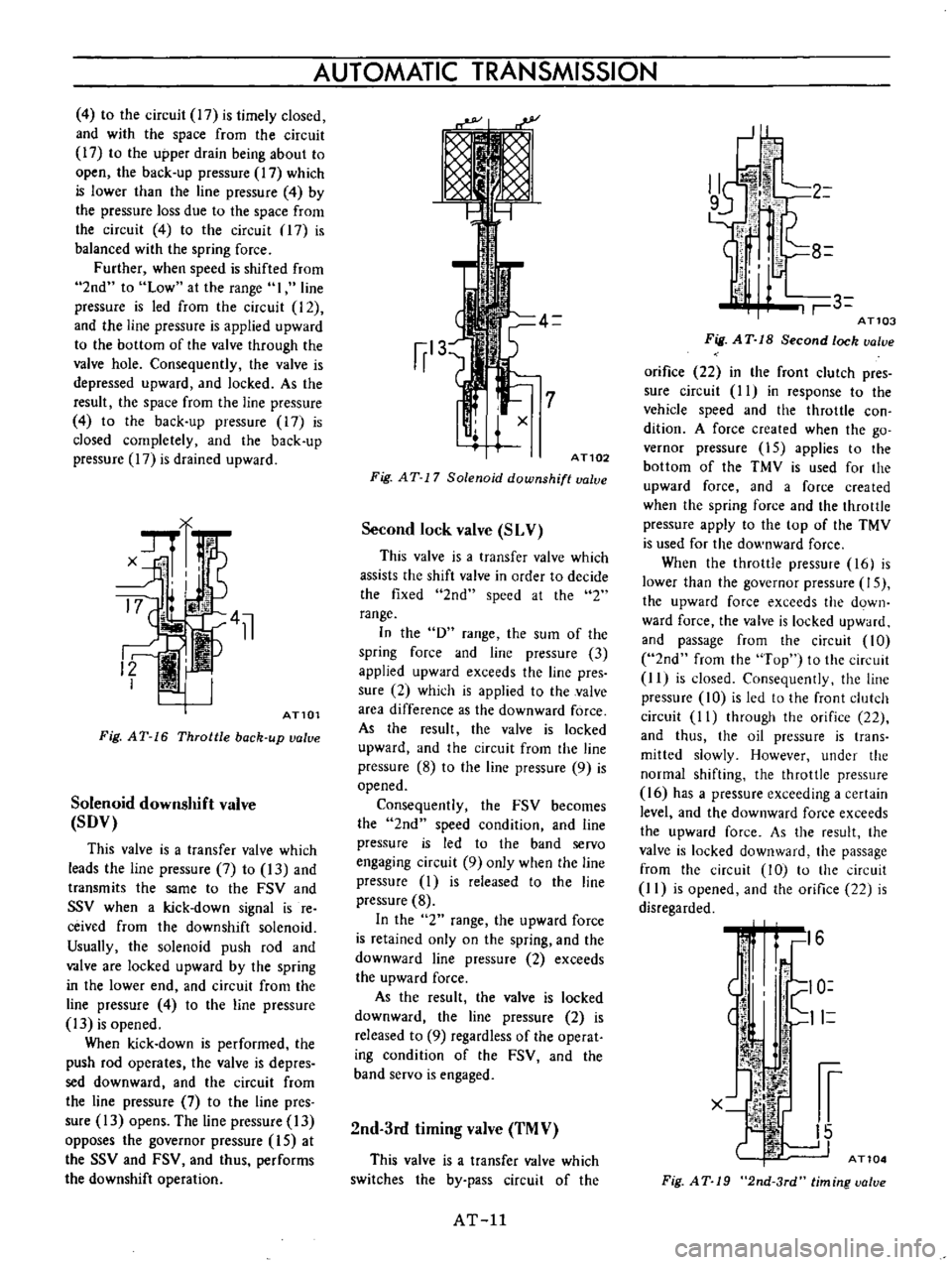
4
to
the
circuit
17
is
timely
closed
and
with
the
space
from
the
circuit
17
to
the
upper
drain
being
about
to
open
the
back
up
pressure
17
which
is
lower
than
the
line
pressure
4
by
the
pressure
loss
due
to
the
space
from
the
circuit
4
to
the
circuit
17
is
balanced
with
the
spring
force
Further
when
speed
is
shifted
from
2nd
to
Low
at
the
range
I
line
pressure
is
led
from
the
circuit
12
and
the
line
pressure
is
applied
upward
to
the
bottom
of
the
valve
through
the
valve
hole
Consequently
the
valve
is
depressed
upward
and
locked
As
the
result
the
space
from
the
line
pressure
4
to
the
back
up
pressure
17
is
closed
completely
and
the
back
up
pressure
17
is
drained
upward
AT101
Fig
AT
16
Throttle
back
up
valve
Solenoid
downshift
valve
SDV
This
valve
is
a
transfer
valve
which
leads
the
line
pressure
7
to
13
and
transmits
the
same
to
the
FSV
and
SSV
when
a
kick
down
signal
is
re
ceived
from
the
downshift
solenoid
Usually
the
solenoid
push
rod
and
valve
are
locked
upward
by
the
spring
in
the
lower
end
and
circuit
from
the
line
pressure
4
to
the
line
pressure
13
is
opened
When
kick
down
is
performed
the
push
rod
operates
the
valve
is
depres
sed
downward
and
the
circuit
from
the
line
pressure
7
to
the
line
pres
sure
13
opens
The
line
pressure
13
opposes
the
governor
pressure
15
at
the
SSV
and
FSV
and
thus
performs
the
downshift
operation
AUTOMATIC
TRANSMISSION
AT102
Fig
AT
17
Solenoid
downshift
value
Second
lock
valve
SLV
This
valve
is
a
transfer
valve
which
assists
the
shift
valve
in
order
to
decide
the
fixed
2nd
speed
at
the
2
range
In
the
D
range
the
sum
of
the
spring
force
and
line
pressure
3
applied
upward
exceeds
the
line
pres
sure
2
which
is
applied
to
the
valve
area
difference
as
the
downward
force
As
the
result
the
valve
is
locked
upward
and
the
circuit
from
the
line
pressure
8
to
the
line
pressure
9
is
opened
Consequently
the
FSV
becomes
the
2nd
speed
condition
and
line
pressure
is
led
to
the
band
servo
engaging
circuit
9
only
when
the
line
pressure
1
is
released
to
the
line
pressure
8
In
the
2
range
the
upward
force
is
retained
only
on
the
spring
and
the
downward
line
pressure
2
exceeds
the
upward
force
As
the
result
the
valve
is
locked
downward
the
line
pressure
2
is
released
to
9
regardless
of
the
operat
ing
condition
of
the
FSV
and
the
band
servo
is
engaged
2nd
3rd
timing
valve
TMV
This
valve
is
a
transfer
valve
which
switches
the
by
pass
circuit
of
the
AT
ll
J
2
3
ATl03
Fig
A
T
18
Second
lock
ualue
orifice
22
in
the
front
clutch
pres
sure
circuit
II
in
response
to
the
vehicle
speed
and
the
throttle
con
dition
A
force
created
when
the
go
vernor
pressure
15
applies
to
the
bottom
of
the
TMV
is
used
for
the
upward
force
and
a
force
created
when
the
spring
force
and
the
throttle
pressure
apply
to
the
top
of
the
TMV
is
used
for
the
downward
force
When
the
throttle
pressure
16
is
lower
than
the
governor
pressure
15
the
upward
force
exceeds
the
down
ward
force
the
valve
is
locked
upward
and
passage
from
the
circuit
10
2nd
from
the
Top
to
the
circuit
II
is
closed
Consequently
the
line
pressure
10
is
led
to
the
front
clutch
circuit
1
I
through
the
orifice
22
and
thus
the
oil
pressure
is
trans
mitted
slowly
However
under
the
normal
shifting
the
throttle
pressure
16
has
a
pressure
exceeding
a
certain
level
and
the
downward
force
exceeds
the
upward
force
As
the
result
the
valve
is
locked
downward
the
passage
from
the
circuit
10
to
the
circuit
1
I
is
opened
and
the
orifice
22
is
disregarded
1
i
16
I
O
11
l1
1
r
X
lp
I
15
J
AT104
Fig
AT
19
2nd
3rd
timing
ualue
Page 17 of 513
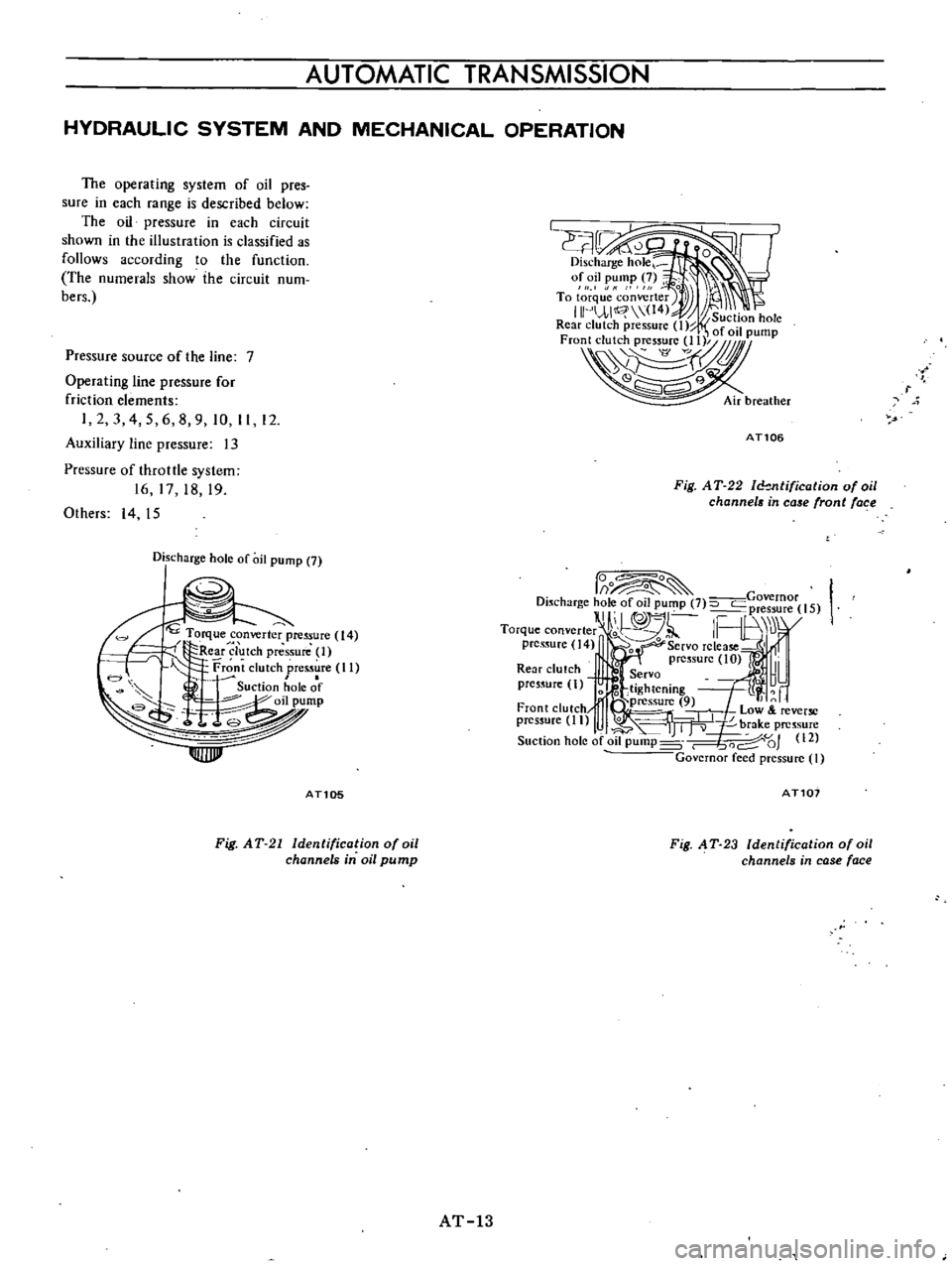
AUTOMATIC
TRANSMISSION
HYDRAULIC
SYSTEM
AND
MECHANICAL
OPERATION
The
operating
system
of
oil
pres
sure
in
each
range
is
described
below
The
oil
pressure
in
each
circuit
shown
in
the
illustration
is
classified
as
follows
according
to
the
function
The
numerals
show
the
circuit
num
bers
Pressure
source
of
the
line
7
Operating
line
pressure
for
friction
elements
I
2
3
4
5
6
8
9
10
II
12
Auxiliary
line
pressure
13
Pressure
of
throttle
system
16
17
18
19
Others
14
15
t
AT106
Fig
AT
22
ld
Jltification
of
oil
channels
in
case
front
fac
e
Discharge
hole
of
oil
pump
7
Torque
c
nver
pre
ure
14
co
t
Re
r
lutch
pressure
l
Front
clutch
pres5ure
II
I
c
Suction
hole
of
t
o
ump
lUlJJl
0
o
f
Governor
Dl5charge
hol
of
011
pUf
lP
7
pressure
15
I
II
nl
1F
Jl
r
Torque
converter
o
L
U
pres
ure
14
It
0
Servo
release
i
I
prc
sUre
IO
Rear
clutch
Servo
L
i
pres
ure
I
0
6
tightening
19
iressu
9
01
Front
clutch
rJj
low
reverse
pressure
II
0
C
lrv
brake
pressure
Suction
hole
of
oil
pump
s
6od
OJ
12
Governor
feed
pressure
I
ATlOS
AT101
Fig
AT
21
Identification
of
oil
channels
in
oil
pu
mp
Fig
AT
23
Identification
of
oil
channels
in
case
face
AT
13
Page 18 of 513
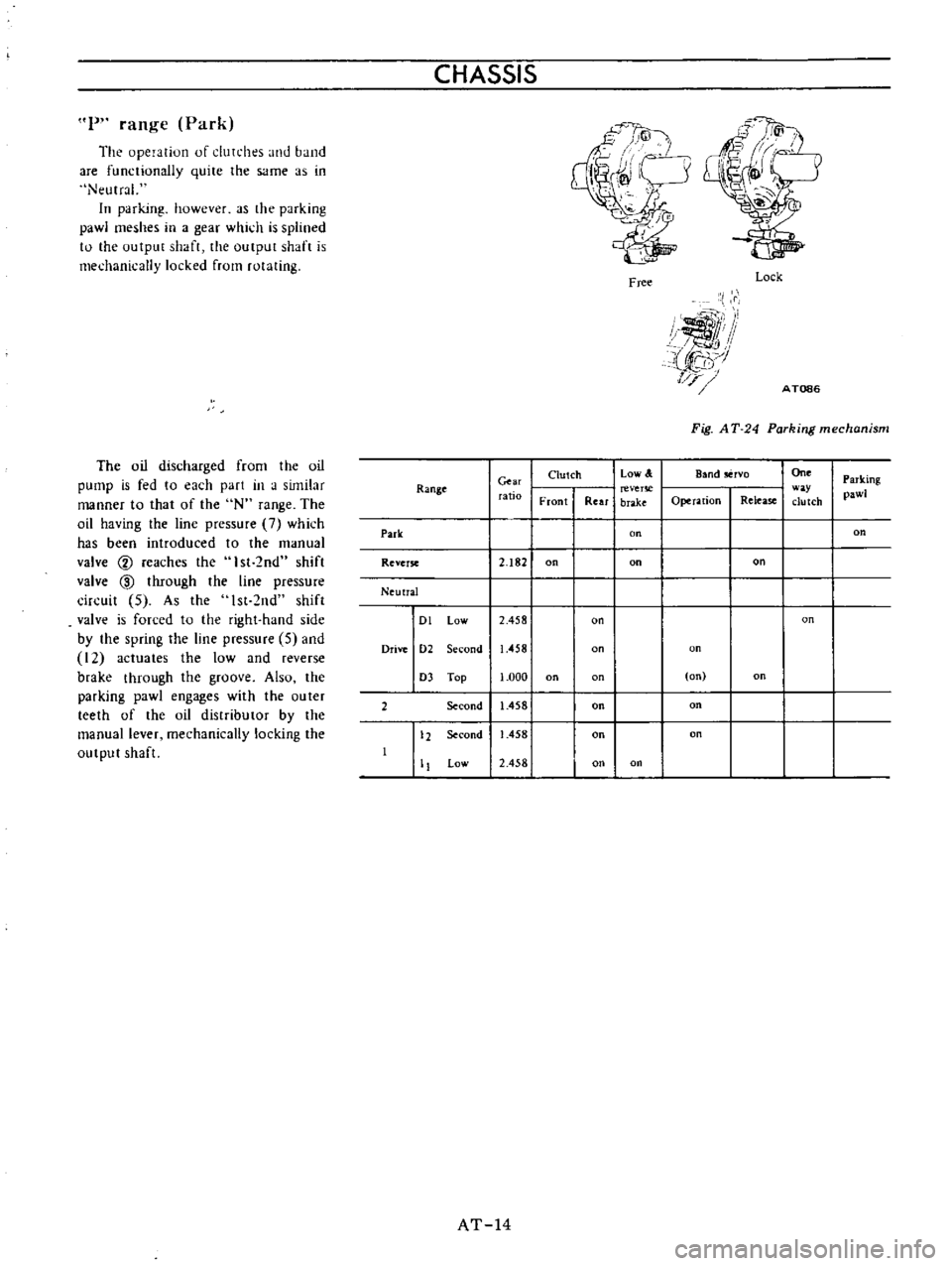
1
range
Park
The
operation
of
clutches
and
band
are
functionally
quite
the
same
as
in
Neutral
In
parking
however
as
the
parking
pawl
meshes
in
a
gear
whkh
is
splined
to
the
output
shaft
the
output
shaft
is
mechanically
locked
from
rotating
The
oil
discharged
from
the
oil
pump
is
fed
to
each
part
in
a
similar
manner
to
that
of
the
N
range
The
oil
having
the
line
pressure
7
which
has
been
introduced
to
the
manual
valve
V
reaches
the
I
st
2nd
shift
valve
ID
through
the
line
pressure
circuit
5
As
the
1st
2nd
shift
valve
is
forced
to
the
right
hand
side
by
the
spring
the
line
pressure
5
and
I2
actuates
the
low
and
reverse
brake
through
the
groove
Also
the
parking
pawl
engages
with
the
au
tee
teeth
of
the
oil
distributor
by
the
manual
lever
mechanically
locking
the
output
shaft
CHASSIS
Free
Lock
I
l
J
1
ri
r
r0
1
1
J
r
A
T086
Fig
AT
24
Parking
mechanism
Ceo
Clutch
Low
Band
rvo
One
Parking
RanKe
atia
rever
w
y
pawl
Front
RUI
brake
Operation
Release
clutch
Park
Reverse
2
182
on
on
Neutral
01
Low
2
458
on
Drive
02
Second
1
458
03
Top
1
000
on
2
Second
1
458
on
on
12
Second
1458
on
II
Low
2
458
on
AT
14